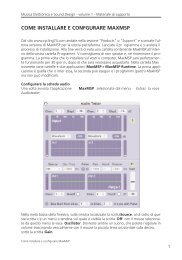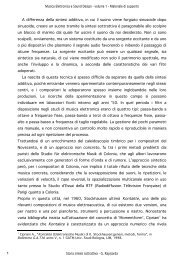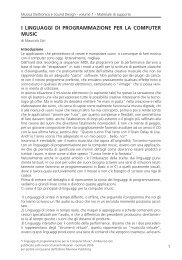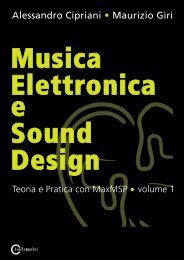programming with max/msp - Virtual Sound
programming with max/msp - Virtual Sound
programming with max/msp - Virtual Sound
Create successful ePaper yourself
Turn your PDF publications into a flip-book with our unique Google optimized e-Paper software.
LEARNING AGENDA 1T<br />
PREREQUISITES FOR THE CHAPTER<br />
• Basic skills in using computers<br />
(operating a computer, managing files and folders, audio formats, etc.)<br />
• minimal knowledge of music theory (semitones, octaves, rhythms, etc.)<br />
LEARNING OBJECTIVES<br />
Knowledge<br />
• to learn aBout the signal paths one uses in sound synthesis and signal processing<br />
• to learn aBout the principal parameters of sound and their characteristics<br />
• to learn how pitch and sound intensity are digitally encoded<br />
• to learn aBout musical intervals in different tuning systems<br />
• to learn aBout audio file formats<br />
SKillS<br />
• to Be aBle to hear changes of frequency and amplitude and to descriBe their<br />
characteristics<br />
• to Be aBle to hear the stages of the envelope of a sound or a glissando<br />
CONTENTS<br />
• computer-Based sound synthesis and signal processing<br />
• theory of timBre, pitch, and sound intensity<br />
• theory of glissandi and amplitude envelopes<br />
• the relationship Between frequency, pitch, and midi encoding<br />
• introduction to sampled sound<br />
• introduction to panning<br />
ACTIVITIES<br />
• interactive examples<br />
TESTING<br />
• questions <strong>with</strong> short answers<br />
• listening and analysis<br />
SUPPORTING MATERIALS<br />
• fundamental concepts<br />
• glossary<br />
from “Electronic Music and <strong>Sound</strong> Design” Vol. 1 by Alessandro Cipriani and Maurizio Giri<br />
© ConTempoNet 2010 - All rights reserved







